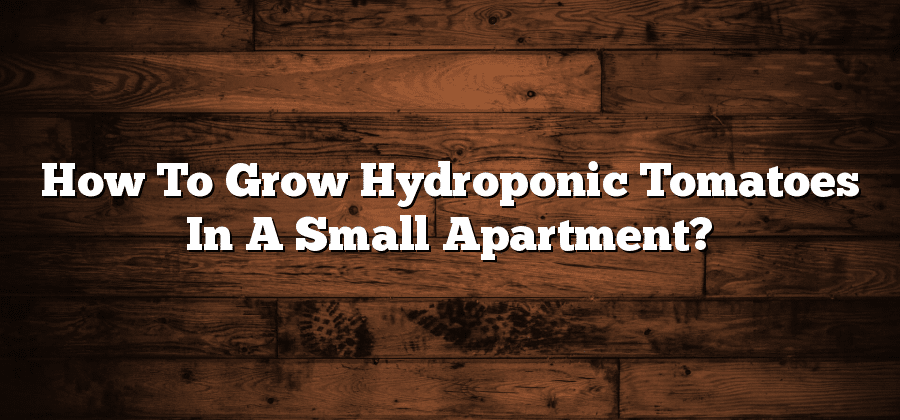Benefits of Growing Hydroponic Tomatoes Indoors
Hydroponic gardening has gained immense popularity in recent years, and growing tomatoes indoors using this method offers numerous benefits. One of the most significant advantages is the ability to control the growing environment. By growing tomatoes hydroponically indoors, you have complete control over factors like temperature, humidity, and nutrient levels. This level of control ensures optimum conditions for the plants, resulting in faster growth rates and higher yields.
Another benefit of growing hydroponic tomatoes indoors is the year-round availability of fresh, homegrown produce. Traditional outdoor gardening is limited to specific seasons, but with hydroponics, you can grow tomatoes all year long, regardless of the weather conditions outside. This means that you can enjoy flavorful, vine-ripened tomatoes even during the winter months when store-bought options may be bland and lacking in taste. Additionally, indoor hydroponic gardens eliminate the need for pesticides and herbicides, promoting healthier, chemical-free tomatoes that are safe and nutritious.
Choosing the Right Hydroponic System
In order to successfully grow hydroponic tomatoes indoors, it is essential to choose the right hydroponic system. There are several factors to consider when making this decision. Firstly, the size and space available for the hydroponic system should be taken into account. If you have limited space, a compact system such as a vertical or stackable system may be the best option. On the other hand, if you have a larger area to work with, a larger system such as a nutrient film technique (NFT) or deep water culture (DWC) system could be more suitable.
Another important factor to consider is the level of expertise and commitment you are willing to invest in your hydroponic system. Some systems, such as aeroponic or drip systems, require more technical knowledge and maintenance. If you are new to hydroponics or have limited time to dedicate to the system, a simpler system like a wick or ebb and flow system might be a better choice.
Lastly, it is crucial to consider your budget when choosing a hydroponic system. Systems with advanced features and high-tech components tend to be more expensive. However, there are also more affordable options available that can still yield excellent results. It is important to find a balance between cost and performance when selecting the right hydroponic system for growing tomatoes indoors.
Selecting the Ideal Tomato Varieties for Indoor Hydroponics
When it comes to selecting the ideal tomato varieties for indoor hydroponics, there are a few key factors to consider. First and foremost, you’ll want to choose varieties that are well-suited to indoor growing conditions. This means selecting tomatoes that are compact in size and have a shorter growing season. Indeterminate varieties, which continue to grow and produce fruit throughout the entire season, may not be the best choice for indoor hydroponics. Instead, look for determinate or “bush” varieties that have a more limited growth habit and can be easily managed in a confined space.
Another important consideration when selecting tomato varieties for indoor hydroponics is their disease resistance. Growing plants in a controlled environment can help reduce the risk of diseases, but it’s still important to select varieties that are resistant to common tomato diseases such as powdery mildew, tomato mosaic virus, and fusarium wilt. Disease-resistant varieties will not only help ensure a healthier crop, but they can also minimize the need for chemical treatments and interventions. Look for varieties with labels that indicate disease resistance, and do some research to find out which diseases are most prevalent in your area. By selecting disease-resistant tomato varieties, you can give your indoor hydroponic garden the best chance for success.
Setting up the Hydroponic System in a Small Apartment
One of the key advantages of growing hydroponic tomatoes indoors is that it can be easily done in a small apartment setting. With limited space, it is crucial to set up the hydroponic system efficiently to maximize the available area.
Firstly, choose a suitable location for your hydroponic setup. Look for an area with ample natural light or consider installing artificial lighting if needed. Ensure the space is well-ventilated to prevent the build-up of excess humidity. Additionally, make sure there is easy access to a water source for the hydroponic system. Once you have identified the location, it is time to assemble the necessary equipment and set up the hydroponic system.
Providing Proper Lighting for Hydroponic Tomatoes
Proper lighting is crucial for the successful growth of hydroponic tomatoes indoors. Since these plants rely solely on artificial light, it is essential to provide them with the right amount and quality of light to promote optimal growth and fruit production.
LED grow lights are highly recommended for hydroponic tomato cultivation due to their energy efficiency and ability to provide the necessary light spectrum for photosynthesis. These lights emit a balanced combination of red and blue wavelengths, which are ideal for promoting vegetative growth and fruit development. Additionally, LED lights generate very little heat, reducing the risk of damaging the delicate tomato plants.
When setting up your hydroponic system, ensure that the lights are positioned at an appropriate distance from the plants to prevent light burn or shade. It is recommended to hang the lights at a height of around six to ten inches above the plants and adjust the distance as they grow. Regular monitoring of the light intensity and duration is also crucial to ensure consistent photosynthesis and prevent potential light deficiencies or excesses.






